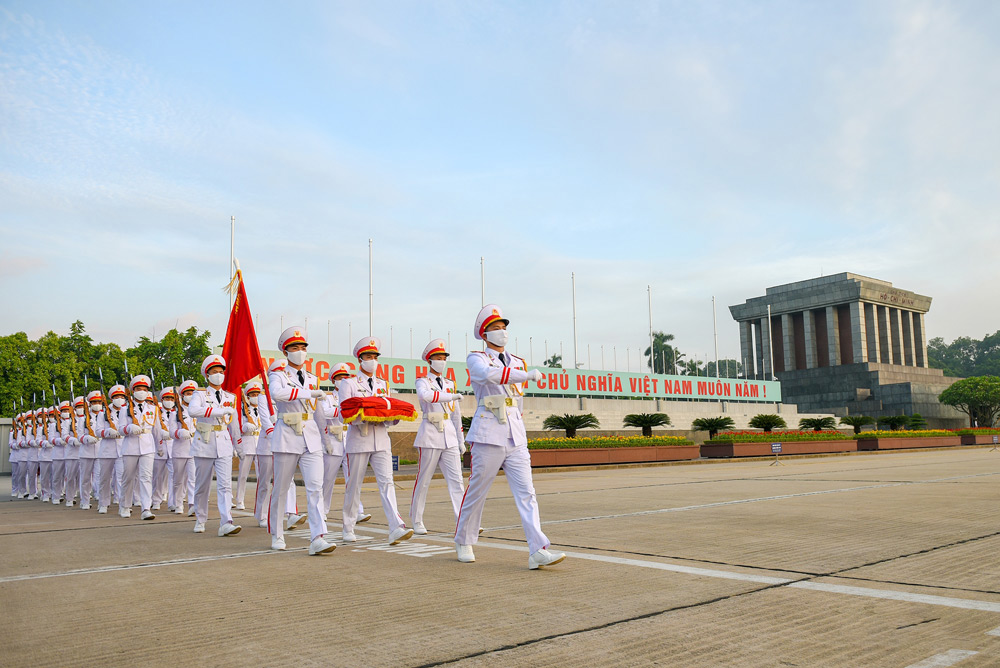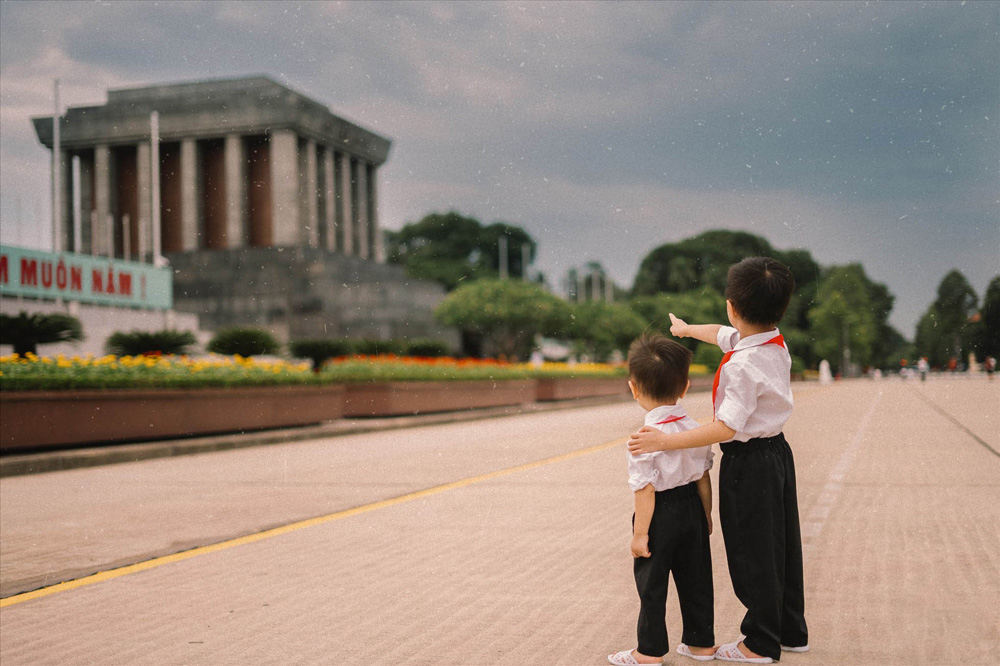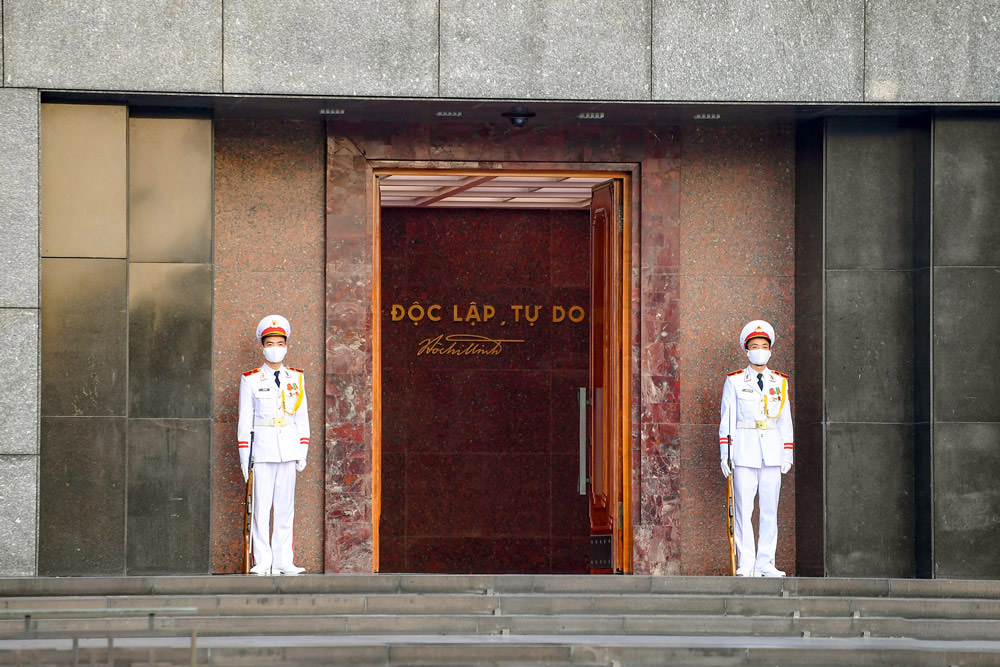In the heart of Hanoi, within the historic Ba Dinh Square, stands a solemn and imposing structure of granite and marble - the Ho Chi Minh Mausoleum. This is more than just a building; it's a powerful symbol of Vietnam's history and a testament to the enduring legacy of its most iconic leader. Ho Chi Minh, affectionately known as "Uncle Ho," led Vietnam's fight for independence and remains a deeply revered figure. Although his wish was to be cremated, the Ho Chi Minh Mausoleum was built as his final resting place, reflecting the immense respect and admiration the Vietnamese people held for him. A visit to this site offers a unique opportunity to connect with Vietnam's past and understand the profound impact of Ho Chi Minh on the nation's identity. This comprehensive guide will prepare you for your visit to the Ho Chi Minh Mausoleum, providing essential information on what to expect, the strict rules and regulations that govern the site, practical tips for planning your visit, and insights into the historical context that makes this such a significant landmark. Prepare to step into a place of solemnity, reverence, and historical importance at the Ho Chi Minh Mausoleum.

The Ho Chi Minh Mausoleum is far more than just a tomb; it's a powerful symbol, a place of pilgrimage, and a unique historical landmark. But what is special about Ho Chi Minh Mausoleum that draws so many visitors each year? It's a combination of its profound historical importance, its architectural presence, and the unique cultural experience it offers.
The Ho Chi Minh Mausoleum serves as a potent symbol of Vietnamese independence and a testament to the enduring legacy of Ho Chi Minh. He is revered as the father of modern Vietnam, the leader who guided the nation through a long and arduous struggle for self-determination. The mausoleum embodies the nation's gratitude and respect for his leadership, representing a unified Vietnam, an ideal he fought tirelessly to achieve. Its presence in Ba Dinh Square, where he declared Vietnam's independence, further reinforces its symbolic importance.
For many Vietnamese people, visiting the Ho Chi Minh Mausoleum is akin to a pilgrimage. It's a deeply personal and emotional experience, a chance to pay their respects to "Uncle Ho," the man who led their country to independence. You'll often see long lines of Vietnamese visitors, from all walks of life, patiently waiting to enter the mausoleum and express their reverence. This palpable sense of respect and national pride makes the mausoleum a truly unique place to observe and reflect upon.
The Ho Chi Minh Mausoleum is also notable for its distinctive architecture. While inspired by Lenin's Mausoleum in Moscow, it incorporates distinctly Vietnamese elements, such as the sloping roof. The imposing structure, built from granite and marble, dominates Ba Dinh Square. Its stark, monumental design reflects the solemnity of its purpose and creates a powerful visual impact. The use of Vietnamese materials and design elements within a Soviet-inspired architectural framework reflects the complex history of the nation itself.
Visiting the Ho Chi Minh Mausoleum offers a unique glimpse into Vietnamese culture and history that you won't find anywhere else in the world. The experience is carefully orchestrated, from the formal dress code to the silent procession through the interior. It's a chance to witness firsthand the deep respect that many Vietnamese people hold for Ho Chi Minh and to gain a deeper understanding of the events that shaped modern Vietnam. The answer to "What is special about Ho Chi Minh Mausoleum?" lies not only in the building itself but also in the profound emotional and historical context that surrounds it. It's a powerful and thought-provoking experience that transcends a typical tourist visit.
This year, 2 September marks the 80th anniversary of Vietnam’s National Day, a historic and highly significant event. Around this time, Hanoi — especially Ba Dinh Square and the Ho Chi Minh Mausoleum area — will be extremely crowded with both locals and tourists gathering for ceremonies and celebrations. If you plan to visit, make sure to arrive early, expect longer waiting times, and prepare for security checks. For a smoother experience, you might consider visiting on a different day close to the holiday when the atmosphere is still festive but less overwhelming.
For more updates on local events and tips, follow us on Facebook to stay informed about any changes or important travel insights.
To ensure a smooth and respectful visit to the Ho Chi Minh Mausoleum, it's essential to plan ahead and be aware of the practicalities. Here's what you need to know:
Understanding the Ho Chi Minh Mausoleum opening hours is crucial, as they are limited and subject to change.
Free of Charge: Currently, there is no Ho Chi Minh Mausoleum entrance fee. Entry to the mausoleum itself is free for both Vietnamese citizens and foreign visitors. This makes it a remarkably accessible site, despite its historical and cultural significance. You do not need to buy any Ho Chi Minh Mausoleum tickets.
When planning your itinerary, you might ask, "How long does it take to see the Ho Chi Minh Mausoleum?"
The Ho Chi Minh Mausoleum is located within Ba Dinh Square in central Hanoi.
By being well-informed about the Ho Chi Minh Mausoleum opening hours, entrance fee (or lack thereof), and other practicalities, you can plan a smooth and meaningful visit to this important site. Remember to arrive early, dress respectfully, and be prepared for a unique and solemn experience.

A visit to the Ho Chi Minh Mausoleum is a unique and, for many, a moving experience. Understanding what to expect inside can help you prepare for the solemnity and formality of the visit.
The journey into the Ho Chi Minh Mausoleum often begins with a queue, which can be quite long, especially during peak tourist season, weekends, and public holidays.
Before entering the mausoleum complex, you'll go through a security checkpoint.
Stepping inside the Ho Chi Minh Mausoleum is a transition into a space of profound solemnity.
The heart of the experience is, of course, the viewing of Ho Chi Minh's body. Here is what you can expect to see Ho Chi Minh Mausoleum inside.
After exiting the main chamber, you'll continue through the mausoleum complex.
Visiting the Ho Chi Minh Mausoleum inside is a unique experience that's both a glimpse into Vietnam's history and a testament to the enduring legacy of its most revered leader. By understanding the procedures and maintaining a respectful demeanor, you can ensure a meaningful and memorable visit to this important site.
Visiting the Ho Chi Minh Mausoleum is a solemn experience that requires adherence to a strict dress code. Understanding and respecting these guidelines is essential for a smooth and meaningful visit. Many visitors wonder, "What to wear to Ho Chi Minh Mausoleum?" Here's a detailed explanation:
The Ho Chi Minh Mausoleum is not just a tourist attraction; it's a site of deep reverence for many Vietnamese people. As such, a strict dress code is enforced to maintain the solemnity and respect of the place. It's crucial to understand that this is not simply a suggestion but a requirement.
Here's a breakdown of what is and isn't acceptable:
It's important to take the dress code seriously.
By adhering to the dress code, you're not only showing respect for Ho Chi Minh and the Vietnamese people but also ensuring that your visit to the Ho Chi Minh Mausoleum is a smooth and meaningful one. It's a small gesture that can make a big difference in your experience and demonstrates your understanding of the cultural significance of this important site. Therefore, it is very important to know "what to wear to Ho Chi Minh Mausoleum".

A common question among those planning a visit to this iconic site is "Can you go inside the Ho Chi Minh Mausoleum?" The answer is yes, but with certain restrictions and guidelines in place to maintain the solemnity and respect that the place commands.
Visitors are permitted to enter the Ho Chi Minh Mausoleum and view the preserved body of Ho Chi Minh, the founding father of modern Vietnam. However, it's important to understand that this is not a casual sightseeing experience. Strict rules and regulations govern the visit, emphasizing respect, order, and decorum. These rules are in place to maintain the sanctity of the site and to honor the memory of Ho Chi Minh. Therefore, the answer to the question "can you go inside the Ho Chi Minh Mausoleum?" is yes, but be prepared to follow the rules.
The interior of the Ho Chi Minh Mausoleum is a carefully controlled environment designed to preserve Ho Chi Minh's body.
Your time inside the Ho Chi Minh Mausoleum will be brief but impactful.
Entering the Ho Chi Minh Mausoleum is a unique experience, unlike any other tourist attraction in Hanoi. By understanding the restrictions, respecting the environment, and preparing for the solemnity of the visit, you can gain a deeper appreciation for this important site and its place in Vietnam's history.
While the Ho Chi Minh Mausoleum is a major highlight, Ba Dinh Square and its surroundings offer a wealth of other historical and cultural attractions that are well worth exploring. You can easily spend several hours or even a full day immersing yourself in this significant area of Hanoi.
Before or after visiting the Mausoleum, take some time to appreciate Ba Dinh Square itself. This vast, open space holds immense historical significance as the very place where Ho Chi Minh read the Declaration of Independence on September 2, 1945, marking the birth of the Democratic Republic of Vietnam. Standing in the square, you can almost feel the echoes of that momentous occasion. The sheer scale of the square is impressive, and it's often used for national parades and events.
A unique spectacle that takes place in Ba Dinh Square is the daily flag-raising and lowering ceremonies. Performed by the military honour guard with precision and solemnity, these ceremonies are a powerful display of national pride.
Witnessing either of these ceremonies is a memorable experience and adds another dimension to your visit to Ba Dinh Square.
Located just a short walk from the Ho Chi Minh Mausoleum, within the same complex, is the One Pillar Pagoda (Chùa Một Cột). This small but historically significant Buddhist temple is renowned for its unique architecture. It's built on a single stone pillar rising from a lotus pond, designed to resemble a lotus blossom, a symbol of purity in Buddhism. Originally dating back to the 11th century, the One Pillar Pagoda is an iconic symbol of Hanoi and a testament to the city's long and rich history.
To gain a deeper understanding of Ho Chi Minh's life, his revolutionary activities, and his enduring legacy, a visit to the Ho Chi Minh Museum is highly recommended. The museum is situated adjacent to the Mausoleum and houses an extensive collection of artifacts, photographs, and documents related to "Uncle Ho" and the Vietnamese struggle for independence. It provides valuable context for understanding the significance of the Ho Chi Minh Mausoleum and Ba Dinh Square.
Just behind the Mausoleum, you can explore the tranquil grounds where Ho Chi Minh lived and worked for many years.
Exploring these sites in addition to the Ho Chi Minh Mausoleum provides a more complete picture of Ho Chi Minh's life and legacy and allows you to fully appreciate the historical and cultural significance of Ba Dinh Square. It's a journey through time that will deepen your understanding of Vietnam's journey to independence and its enduring respect for its revolutionary leader.
The Ho Chi Minh Mausoleum stands as a powerful symbol of Vietnam's past, a testament to its struggle for independence, and a place of deep reverence for its most iconic leader. More than just a monument, it's a window into the soul of a nation, offering a unique opportunity to connect with its history and understand the profound legacy of Ho Chi Minh. Visiting the mausoleum, witnessing the respect shown by the Vietnamese people, and exploring the surrounding historical sites within Ba Dinh Square is an experience that will undoubtedly leave a lasting impression. We encourage you to add this unique landmark to your Hanoi itinerary and discover for yourself the solemn beauty and historical weight that the Ho Chi Minh Mausoleum holds.
To elevate your visit to the Ho Chi Minh Mausoleum and your overall journey through Vietnam to an even more meaningful level, consider the expertise of Asia Mystika. We craft tailor-made experiences that go far beyond typical itineraries, ensuring your adventure is perfectly aligned with your interests and guided by those who know the country best. Our local experts offer unique insights, providing a deeper understanding of the historical context and cultural significance of sites like the Mausoleum. With Asia Mystika, you can travel with confidence, knowing that every detail is meticulously arranged by a trustworthy team dedicated to creating unforgettable memories. And our focus on value for money ensures that your investment delivers an enriching and seamless travel experience.
Ready to embark on a journey through Vietnam's history and culture, including a visit to the Ho Chi Minh Mausoleum? Explore our inspiring range of Vietnam tour packages and let us help you design your perfect adventure. We invite you to share your own reflections on the Mausoleum, your travel plans, or any questions you may have in the comments below. Let your exploration of Vietnam's captivating past begin!


